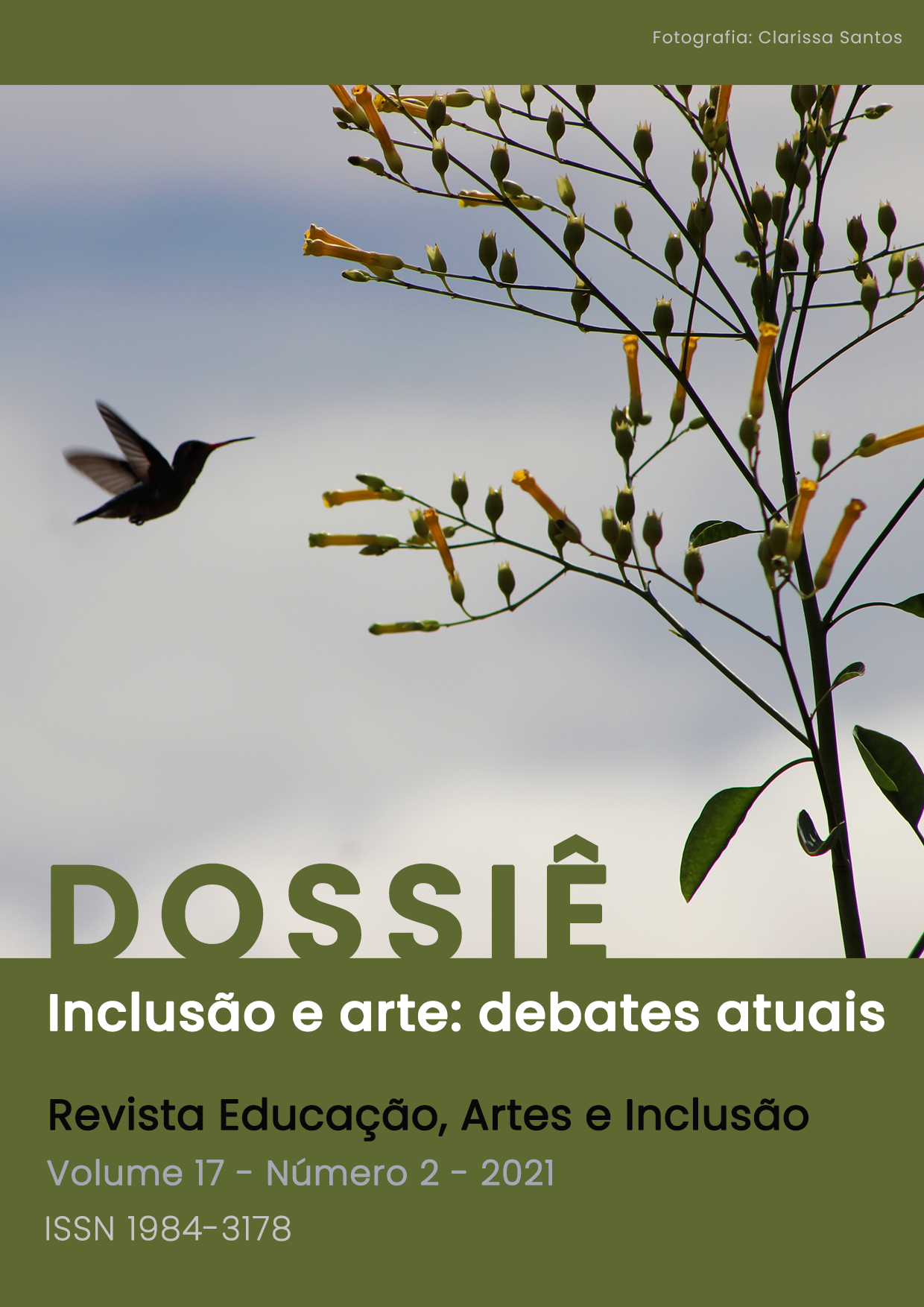O papel da arte no desenvolvimento da criatividade em crianças da educação infantil: o que pensam e fazem os professores
DOI:
https://doi.org/10.5965/198431781722021110Palabras clave:
Criatividade, Educação infantil, Prática docente, Arte-educaçãoResumen
A criatividade desenvolve-se no contexto social e cultural, caracterizando-se como instrumento de expressão, compreensão do eu e do coletivo. Ao longo do século XX o papel da criatividade na educação ganhou destaque, devido às constantes mudanças sociais, culturais e tecnológicas, e encontra na arte meios para seu desenvolvimento. Sendo assim, o que pensam e fazem os professores sobre a criatividade dos estudantes? Para responder tal questionamento, o objetivo da pesquisa é analisar as concepções e ações docentes que proporcionam o desenvolvimento da criatividade, com foco em estudantes da Educação Infantil. A presente pesquisa caracteriza-se em um estudo de campo, a partir de observação indireta, e utiliza como instrumento de coleta de dados a entrevista face a face, semiestruturada, com perguntas referentes ao conhecimento dos conceitos e práticas da criatividade com professoras de cinco escolas de Educação Infantil. Os resultados apontados reafirmam a arte como o componente que possui maior possibilidade de desenvolvimento da criatividade e destacam a necessidade da formação inicial do professor ser direcionada para possibilitar a atuação criativa de sua profissão, bem como a necessidade constante de busca, rompendo com os paradigmas e estereótipos, e cultivando a criatividade na escola.
Descargas
Citas
BARBOSA, Ana Mae. CUNHA, Fernanda Pereira da, (Orgs). A Abordagem Triangular no Ensino das Artes e Culturas Visuais. São Paulo: Cortez, 2010.
BRASIL. Ministério da Educação; CONSED; UNDIME Nacional. Base Nacional Comum Curricular: Proposta Preliminar, Segunda Versão Revista, abril 2016. Disponível em: <http://portal.mec.gov.br/docman/maio-2016-pdf/40791-bncc-proposta-preliminar-segunda-versao-pdf/file> Acesso em: 15 de mar. de 2020.
BRASIL. Ministério da Educação. Resolução CNE/CEB 5/2009. Diário Oficial da União, Brasília, 18 de dezembro de 2009, Seção 1, p. 18. Disponível em: < http://www.seduc.ro.gov.br/portal/legislacao/RESCNE005_2009.pdf> Acesso em: 06 de jul. de 2021.
DAVIES, Dan. HOWE, Alan. O que significa ser criativo? In: MOYLES, Janet e colaboradores. Fundamentos da Educação Infantil: enfrentando o desafio. Porto Alegre: Artmed, 2010. p. 261-275.
FERNANDES, Vera Lúcia Penzo. A Criatividade no ensino de Artes Visuais: da reprodução à inclusão. 1. Ed. – Curitiba: Appris, 2016.
JAPIASSU, Ricardo Ottoni Vaz. Criatividade, Criação e Apreciação Artística: a Atividade Criadora Segundo Vygotsky. In: VASCONCELLOS, Mário Sérgio (org.). Criatividade: Psicologia, educação e conhecimento do novo. São Paulo: Moderna, 2001. p. 43-58.
JUSTO, José Sterza. Criatividade no Mundo Contemporâneo. In: VASCONCELOS, Mário Sérgio (org.). Criatividade: Psicologia, educação e conhecimento do novo. São Paulo: Moderna, 2001. p. 59-78.
KASTRUP, Virgínia. Aprendizagem, Arte e Invenção. Psicologia em Estudo, Maringá, v. 6, n. 1, p. 17-27, jan./jun. 2001.
LOWENFELD, Victor. BRITTAIN, W. Lambert. Desenvolvimento da capacidade criadora. São Paulo: Editora Mestre Jou, 1970.
OLIVEIRA, Maria Lucia de. Contribuições da Psicanálise para a Compreensão da Criatividade. In: VASCONCELOS, Mário Sérgio (org.). Criatividade: Psicologia, educação e conhecimento do novo. São Paulo: Moderna, 2001. p. 21-42
OSTROWER, Fayga. Criatividade e Processos de criação. 25 ed. Petrópolis: Vozes, 2010.
PIAGET, Jean. Criatividade. In: VASCONCELLOS, Mário Sérgio (org.). Criatividade: Psicologia, educação e conhecimento do novo. São Paulo: Moderna, 2001. p. 11-20
VIGOTSKY, Lev Semionovitch. Imaginação e criação na infância. São Paulo: Ática, 2009.
Descargas
Publicado
Cómo citar
Número
Sección
Licencia
Derechos de autor 2021 Sara Mandolini, Eliane Patricia Grandini Serrano

Esta obra está bajo una licencia internacional Creative Commons Atribución-NoComercial 4.0.
Declaración de Derecho de Autor
Los autores que publican en esta revista concuerdan con los siguientes términos:
(A) Autores mantiene los derechos de autor y concede a la revista el derecho de primera publicación, con el trabajo simultáneamente licenciado bajo la Licencia Creative Commons Attribution que permite el compartir el trabajo con reconocimiento de la autoría y publicación inicial en esta revista.
(B) Autores tienen autorización para asumir contratos adicionales por separado, para distribución no exclusiva de la versión del trabajo publicada en esta revista (por ejemplo, publicar en repositorio institucional o como capítulo de libro), con reconocimiento de autoría y publicación inicial en esta revista.
(C) Esta revista proporciona acceso público a todo su contenido, ya que esto permite una mayor visibilidad y alcance de los artículos y reseñas publicadas. Para obtener más información acerca de este enfoque, visite el Public Knowledge Project.
Esta revista tiene una licencia Creative Commons Attribution-NonCommercial 4.0 International. Esta licencia permite que otros remezclen, modifiquen y desarrollen su trabajo con fines no comerciales, y aunque los trabajos nuevos deben acreditarlo y no pueden usarse comercialmente, los usuarios no están obligados a licenciar estos trabajos derivados bajo los mismos términos.





